Family
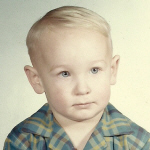
 My brother-in-law, Ron Schulenberg was the youngest of six children, and the second boy in the family. He was often told what to do by his older siblings, and especially his sisters, because, well…that’s what older sisters do. We were raised taking care of the younger siblings, and that just naturally included babysitting them and in general, telling them what to do. Of course, that doesn’t necessarily mean that the younger children appreciated that “influence” from the older siblings. In fact, most times, the younger kids, didn’t appreciate that bossiness of their older siblings…especially as they got a little bit older.
My brother-in-law, Ron Schulenberg was the youngest of six children, and the second boy in the family. He was often told what to do by his older siblings, and especially his sisters, because, well…that’s what older sisters do. We were raised taking care of the younger siblings, and that just naturally included babysitting them and in general, telling them what to do. Of course, that doesn’t necessarily mean that the younger children appreciated that “influence” from the older siblings. In fact, most times, the younger kids, didn’t appreciate that bossiness of their older siblings…especially as they got a little bit older.
My brother-in-law was always being told what to do, but not quite as often by his older brother, Bob, my 
 husband. Maybe it was because Bob understood how it was to be the boy among multiple sisters, or maybe it was because Bob was fourteen when his brother was born, so by the time Ron could be much trouble, Bob was already grown up and out of the household…having moved out when he was eighteen. That also gave Ron a little different relationship with his brother, who didn’t mind have his “kid brother” tag along, even on some of our daytime dates, like Dairy Queen and such. We took Ron a number of places with us, and I’m sure my mother-in-law enjoyed the break very much. I didn’t mind the “tag-along” either, since I never had a brother, just four sisters, it was ok with me…and, Bob might have thought that brothers should stick together.
husband. Maybe it was because Bob understood how it was to be the boy among multiple sisters, or maybe it was because Bob was fourteen when his brother was born, so by the time Ron could be much trouble, Bob was already grown up and out of the household…having moved out when he was eighteen. That also gave Ron a little different relationship with his brother, who didn’t mind have his “kid brother” tag along, even on some of our daytime dates, like Dairy Queen and such. We took Ron a number of places with us, and I’m sure my mother-in-law enjoyed the break very much. I didn’t mind the “tag-along” either, since I never had a brother, just four sisters, it was ok with me…and, Bob might have thought that brothers should stick together.
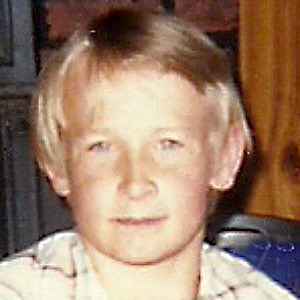
 These days, Ron and Bob are still close, helping each other as needed. They are both mechanics, so they work on their own cars and the cars of friends. Ron has an extensive shop, so many of the tools Bob or their nephews might need are available through Ron. Sometimes, you have to have a little help working on a car. Ron has a pretty lucrative “side hustle” with his mechanics work, and it keeps him busy too. He spends a good portion of each day working on someone’s car. No bad for a part-time gig. Today is Ron’s birthday. Happy birthday Ron!! Have a great day!! We love you!!
These days, Ron and Bob are still close, helping each other as needed. They are both mechanics, so they work on their own cars and the cars of friends. Ron has an extensive shop, so many of the tools Bob or their nephews might need are available through Ron. Sometimes, you have to have a little help working on a car. Ron has a pretty lucrative “side hustle” with his mechanics work, and it keeps him busy too. He spends a good portion of each day working on someone’s car. No bad for a part-time gig. Today is Ron’s birthday. Happy birthday Ron!! Have a great day!! We love you!!
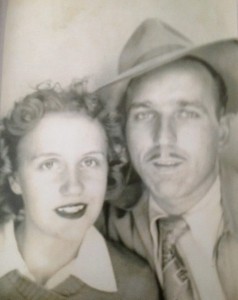
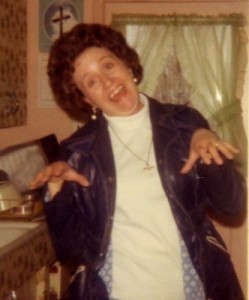 As our tenth year without our mom, Collene Spencer approaches, and in fact, it’s ten years without parents, I think my sisters, Cheryl Masterson, Caryl Reed, Alena Stevens, Allyn Hadlock, and I have been thinking a lot about her. Time doesn’t seem to go by so fast, until it is passing without a loved one. Then you just wonder, how could it be ten years already? And yet it is. Ten years without Mom’s goofiness, her laughter, her zest for life, and mostly…her presence, just seems impossible. I think that is what I miss the most…her presence. Just knowing that I could call her to ask a question, or to tell her about her new little great great grandchildren. Mom loved being a grandmother. She loved being a mom too. Her home and her family were her pride and joy. I know that while she is in Heaven, she still knows and sees how much her family has grown, and I know that she is so happy and so proud. I think we have all tried to live lives that would make our parents proud. From the oldest to the newest great great grandbaby, Mom would be so proud.
As our tenth year without our mom, Collene Spencer approaches, and in fact, it’s ten years without parents, I think my sisters, Cheryl Masterson, Caryl Reed, Alena Stevens, Allyn Hadlock, and I have been thinking a lot about her. Time doesn’t seem to go by so fast, until it is passing without a loved one. Then you just wonder, how could it be ten years already? And yet it is. Ten years without Mom’s goofiness, her laughter, her zest for life, and mostly…her presence, just seems impossible. I think that is what I miss the most…her presence. Just knowing that I could call her to ask a question, or to tell her about her new little great great grandchildren. Mom loved being a grandmother. She loved being a mom too. Her home and her family were her pride and joy. I know that while she is in Heaven, she still knows and sees how much her family has grown, and I know that she is so happy and so proud. I think we have all tried to live lives that would make our parents proud. From the oldest to the newest great great grandbaby, Mom would be so proud.
Mom met our dad, Al Spencer, when she was just a girl. Mom knew immediately that he was the one for hr. She 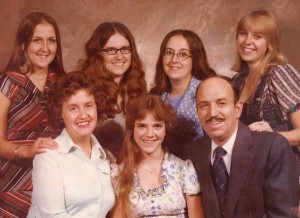 remembered thinking, “What a handsome man!!” They married when she was still 17 years old. They immediately moved to Superior, Wisconsin and began a family. Ten months later my sister, Cheryl was born. I followed two years later. My sister, Caryl was born three years after I was. My sister, Alena followed two years later, and my sister, Allyn two years after that. Of course, we moved back to Casper before Caryl was born and have lived here since that time. Wyoming was where Mom’s family was, as well as part of Dad’s family, so moving here was logical. They loved Wyoming, and they thrived here.
remembered thinking, “What a handsome man!!” They married when she was still 17 years old. They immediately moved to Superior, Wisconsin and began a family. Ten months later my sister, Cheryl was born. I followed two years later. My sister, Caryl was born three years after I was. My sister, Alena followed two years later, and my sister, Allyn two years after that. Of course, we moved back to Casper before Caryl was born and have lived here since that time. Wyoming was where Mom’s family was, as well as part of Dad’s family, so moving here was logical. They loved Wyoming, and they thrived here.
My mom was a great Christian woman. While she loved her family, and especially our dad, her first love was for her God. She accepted Jesus as her Lord and Savior many years ago, and she never looked back. She told anyone who would listen, just how important it was to receive Jesus. Through her, countless numbers of people were saved. My sisters and I never really felt as comfortable as Mom with witnessing to people. And in our teen 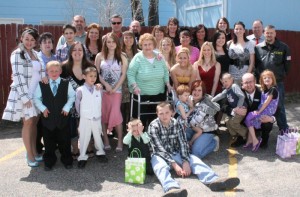
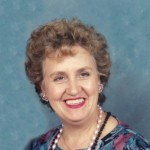 years, we often wished she wouldn’t witness when we were around. We were embarrassed, but she wasn’t. She knew that her work was important, and she was right. I know that when she entered Heaven, our Father told her, “Well done, thou good and faithful servant. We are so proud of her and hope to live up to her example. Today is the tenth anniversary of Mom’s graduation to Heaven. Mom, we love and miss you and Dad very much and can’t wait to see you when we all get there.
years, we often wished she wouldn’t witness when we were around. We were embarrassed, but she wasn’t. She knew that her work was important, and she was right. I know that when she entered Heaven, our Father told her, “Well done, thou good and faithful servant. We are so proud of her and hope to live up to her example. Today is the tenth anniversary of Mom’s graduation to Heaven. Mom, we love and miss you and Dad very much and can’t wait to see you when we all get there.
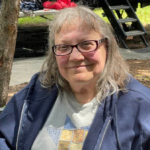
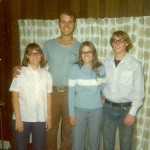 When I met my sister-in-law, Debbie Cook, over 50 years ago, we became friends right away. We both worked at Kmart then. She was in the Deli, and I was in the Millinery Department (handbags, gloves, and wigs, in case you didn’t know). In fact, it was at Kmart, where I met my future husband, Bob, who is Debbie’s brother. As our friendship grew, we decided to make each other our maid of honor at our weddings. Debbie and her husband, LJ were married first, on June 8, 1974. Bob and I were married on March 1, 1975, nine months later. As we had planned, I was her maid of honor, and she was my matron of honor. At that time, as with any marriage, there are no guarantees, but both marriages made it to our fiftieth anniversaries. Debbie and LJ celebrated theirs on June 8th, 2024, and we will celebrate ours on March 1st.
When I met my sister-in-law, Debbie Cook, over 50 years ago, we became friends right away. We both worked at Kmart then. She was in the Deli, and I was in the Millinery Department (handbags, gloves, and wigs, in case you didn’t know). In fact, it was at Kmart, where I met my future husband, Bob, who is Debbie’s brother. As our friendship grew, we decided to make each other our maid of honor at our weddings. Debbie and her husband, LJ were married first, on June 8, 1974. Bob and I were married on March 1, 1975, nine months later. As we had planned, I was her maid of honor, and she was my matron of honor. At that time, as with any marriage, there are no guarantees, but both marriages made it to our fiftieth anniversaries. Debbie and LJ celebrated theirs on June 8th, 2024, and we will celebrate ours on March 1st.
Our lives took turns that were the same and turns that took us in different directions. We both had daughters. 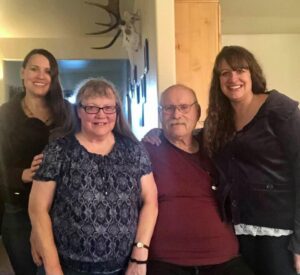
 Bob and I had two daughters, Corrie Petersen and Amy Royce. Debbie and LJ had three daughters, Machelle Moore, Nancy Cook (who passed away shortly after her birth), and Susan Griffith. The girls spent a lot of time together…until Debbie and LJ moved first to Thermopolis and then to Powell. After that, while the girls were still friends, they didn’t see as much of each other as they had before. That part made us sad, but life takes us in different directions sometimes. The moves to Thermopolis and Powell were what was best for Debbie, LJ, and their girls. In fact, they still live in Powell today.
Bob and I had two daughters, Corrie Petersen and Amy Royce. Debbie and LJ had three daughters, Machelle Moore, Nancy Cook (who passed away shortly after her birth), and Susan Griffith. The girls spent a lot of time together…until Debbie and LJ moved first to Thermopolis and then to Powell. After that, while the girls were still friends, they didn’t see as much of each other as they had before. That part made us sad, but life takes us in different directions sometimes. The moves to Thermopolis and Powell were what was best for Debbie, LJ, and their girls. In fact, they still live in Powell today.
There were some other differences too. Bob and I had three grandsons and one granddaughter, while Debbie and LJ had two grandsons and two granddaughters. Bob and I also have one great granddaughter and five great grandsons, while Debbie and LJ don’t have great grandchildren yet, but that day will come too. There 
 could well be more great grandchildren in all our futures. Life has taken us in different directions over the years, but it has also taken us to the same place too…our golden anniversaries. We have remained sisters and brothers-in-law. And we have remained friends. We have shared a family, her family, my in-laws. We have shared history, experiencing many of the same things. We may have taken a few different paths, but we have arrived together. Today is Debbie’s birthday. Happy 72nd birthday Debbie!! Have a great day!! We love you!!
could well be more great grandchildren in all our futures. Life has taken us in different directions over the years, but it has also taken us to the same place too…our golden anniversaries. We have remained sisters and brothers-in-law. And we have remained friends. We have shared a family, her family, my in-laws. We have shared history, experiencing many of the same things. We may have taken a few different paths, but we have arrived together. Today is Debbie’s birthday. Happy 72nd birthday Debbie!! Have a great day!! We love you!!

 Most Christians have heard about the Biblical battle of Jericho. If you know the story, you know that the Israelites marched around the city walls once a day for six days, then seven times on the seventh day, and the walls of Jericho fell after they shouted, and the priests blew their trumpets. That was one of the epic battles that the Israelites were involved in. Jericho took a beating that day, but since then Jericho hasn’t always lived a peaceful life since then either.
Most Christians have heard about the Biblical battle of Jericho. If you know the story, you know that the Israelites marched around the city walls once a day for six days, then seven times on the seventh day, and the walls of Jericho fell after they shouted, and the priests blew their trumpets. That was one of the epic battles that the Israelites were involved in. Jericho took a beating that day, but since then Jericho hasn’t always lived a peaceful life since then either.
On the morning of February 21, 1918, the combined Allied forces of British troops and the Australian mounted cavalry captured the city of Jericho in Palestine. The capture came after a three-day battle with Turkish troops.  The Allied troops, commanded by British General Edmund Allenby, began the offensive on Tuesday, February 19th, on the outskirts of Jerusalem. The operation was plagued by adverse weather conditions and the very determined Turkish enemy. Nevertheless, the Allies were able to move nearly 20 miles toward Jericho in just three days.
The Allied troops, commanded by British General Edmund Allenby, began the offensive on Tuesday, February 19th, on the outskirts of Jerusalem. The operation was plagued by adverse weather conditions and the very determined Turkish enemy. Nevertheless, the Allies were able to move nearly 20 miles toward Jericho in just three days.
Despite their determination, it was apparent by the morning of February 21, that the Turkish line had been broken, and the Allied forces entered the holy city of Jericho without much resistance at just after 8am. When they realized that they had lost control of the city, the Turkish troops chose to retreat rather than fight, meaning the three-day battle with the Allied troops ended much like the Biblical battle…Jericho simply surrendered. The Allies captured 46 Turkish prisoners, on that fateful day.

 Just as it had been in Biblical times, the capture of Jericho proved to be an important strategic victory for the Allies. They now controlled some of the most important roads in the region, including the main road to the coast and the mountain highway leading to Jerusalem, and they had reached the northern end of the Dead Sea, the lowest point on earth at 1,290 feet below sea level.
Just as it had been in Biblical times, the capture of Jericho proved to be an important strategic victory for the Allies. They now controlled some of the most important roads in the region, including the main road to the coast and the mountain highway leading to Jerusalem, and they had reached the northern end of the Dead Sea, the lowest point on earth at 1,290 feet below sea level.
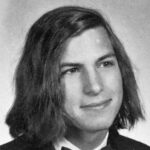
 In 1976, while I was married, having kids and raising a family, a man named Steve Jobs was creating Apple, a company that would change my life and the lives of many other people. At that time, most of us hadn’t really heard of computers, much less actually used one. Nevertheless, the future would bring a computer in almost every home, and in fact, one in almost every hand. My own introduction to the world of computers would come a little over a decade later when I went to work for an agent with Farmers Insurance. The computer we had there was a closed DOS system, so there was nothing like the internet and surfing the web. For me, that would come yet another decade later while working for an Allstate agent…again on a closed system. By that time, I was hooked and that closed system just didn’t do it for me anymore. So, as a mother of two and a grandmother of three (at that time…one more grandson would follow very soon), I bought my first computer…a Gateway. It was a good computer, but nothing like the models we have today, and these days, it would have driven me up a wall. My phone is, of course, an iPhone, and my computer is a Lenovo laptop. One day maybe I will have a Mac laptop. We shall see. My niece, Liz Masterson loves them.
In 1976, while I was married, having kids and raising a family, a man named Steve Jobs was creating Apple, a company that would change my life and the lives of many other people. At that time, most of us hadn’t really heard of computers, much less actually used one. Nevertheless, the future would bring a computer in almost every home, and in fact, one in almost every hand. My own introduction to the world of computers would come a little over a decade later when I went to work for an agent with Farmers Insurance. The computer we had there was a closed DOS system, so there was nothing like the internet and surfing the web. For me, that would come yet another decade later while working for an Allstate agent…again on a closed system. By that time, I was hooked and that closed system just didn’t do it for me anymore. So, as a mother of two and a grandmother of three (at that time…one more grandson would follow very soon), I bought my first computer…a Gateway. It was a good computer, but nothing like the models we have today, and these days, it would have driven me up a wall. My phone is, of course, an iPhone, and my computer is a Lenovo laptop. One day maybe I will have a Mac laptop. We shall see. My niece, Liz Masterson loves them.
My iPhone is by far my favorite item, so I guess, I have Steve Jobs, and his associates, Steve Wozniak, and Ronald Wayne to thank for that. Apple Inc, which was originally Apple Computer, Inc, is a multinational 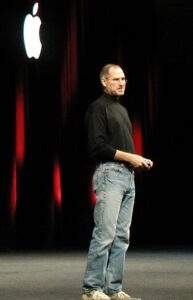 corporation that creates and markets consumer electronics and attendant computer software and is a digital distributor of media content. Apple’s core product lines are the iPhone smartphone, iPad tablet computer, and the Mac personal computer. The company offers its products online and has a chain of retail stores known as Apple Stores. The men founded the company on April 1, 1976, in the childhood family home of Steve Jobs on Crist Drive in Los Altos, California. The original site of Apple Computer, Inc, was added to a list of historic Los Altos sites in 2013. They started the company to market Wozniak’s Apple I desktop computer. Jobs and Wozniak incorporated the company on January 3, 1977, in Cupertino, California.
corporation that creates and markets consumer electronics and attendant computer software and is a digital distributor of media content. Apple’s core product lines are the iPhone smartphone, iPad tablet computer, and the Mac personal computer. The company offers its products online and has a chain of retail stores known as Apple Stores. The men founded the company on April 1, 1976, in the childhood family home of Steve Jobs on Crist Drive in Los Altos, California. The original site of Apple Computer, Inc, was added to a list of historic Los Altos sites in 2013. They started the company to market Wozniak’s Apple I desktop computer. Jobs and Wozniak incorporated the company on January 3, 1977, in Cupertino, California.
Jobs was born on February 24, 1955, to Joanne Carole Schieble and Abdulfattah “John” Jandali. Because Jandali was Muslim, Schieble’s parents objected to the marriage, so she traveled to San Francisco to give birth to her son and place him for adoption. Schieble requested that her son be adopted by college graduates. A lawyer and his wife were selected, but they withdrew after discovering that the baby was a boy, so Jobs was instead adopted by Paul Reinhold and Clara (née Hagopian) Jobs. Since they lacked a college education, Schieble initially refused to sign the adoption papers and went to court to request that her son be removed from the Jobs household and placed with a different family but changed her mind after Paul and Clara promised to pay for their son’s college tuition. He chose Reed College, which was an expensive college, and after a year, dropped out because he didn’t want to financially burden his parents. Instead he audited the courses he wanted to take, and while he never got a degree, he did get the necessary knowledge. And so began the life and career of a man who would change technology.
Jobs’ vision for user-friendly devices began with the Apple I and grew rapidly from there with groundbreaking products like the Macintosh, iPod, iPhone, and iPad. Jobs was a man known for his perfectionism and marketing genius. He was perfect for that company, and he revolutionized personal computing, music, and mobile 
 communication. He inspired the global tech revolution with his “Think Different” philosophy, making Apple one of the most influential companies in history. He left a legacy defined by his innovation, creativity, and relentless pursuit of excellence. In 1985, Jobs was awarded the National Medal of Technology from President Ronald Reagan, awarded jointly with Steve Wozniak. Unfortunately, he died far too young from pancreatic cancer complications on October 5, 2011, at the age of just 56 years.
communication. He inspired the global tech revolution with his “Think Different” philosophy, making Apple one of the most influential companies in history. He left a legacy defined by his innovation, creativity, and relentless pursuit of excellence. In 1985, Jobs was awarded the National Medal of Technology from President Ronald Reagan, awarded jointly with Steve Wozniak. Unfortunately, he died far too young from pancreatic cancer complications on October 5, 2011, at the age of just 56 years.
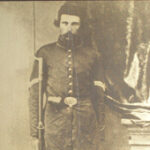
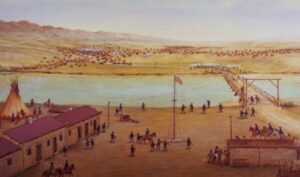 Everyone has heard of “Custer’s Last Stand,” but what about “Custard’s Last Stand.” Well, it is a real thing. I was shocked when I heard that too. The battle actually had two names. It was known first as the Battle of Red Buttes, and it was fought in 1865, near modern-day Casper between American Indians and US Cavalry soldiers, but it was also known as “Custard’s Last Stand.” It was a small battle, but it was significant too. It directly contributed to the Battle of Little Bighorn, which was also known as “Custer’s Last Stand” and was also the way Casper, Wyoming got its name.
Everyone has heard of “Custer’s Last Stand,” but what about “Custard’s Last Stand.” Well, it is a real thing. I was shocked when I heard that too. The battle actually had two names. It was known first as the Battle of Red Buttes, and it was fought in 1865, near modern-day Casper between American Indians and US Cavalry soldiers, but it was also known as “Custard’s Last Stand.” It was a small battle, but it was significant too. It directly contributed to the Battle of Little Bighorn, which was also known as “Custer’s Last Stand” and was also the way Casper, Wyoming got its name.
Everyone knows about the Battle of Little Bighorn, which is also known as “Custer’s Land Stand” mainly because Lieutenant Colonel George Armstrong Custer, commander of the 7th Cavalry Regiment, was among the 286 US soldiers killed while fighting warriors from the Lakota Sioux, Northern Cheyenne and Arapaho tribes. Well, “Custard’s Last Stand” was also named after a man who was killed in the battle. Following the American Civil War, which wrapped up in the summer of 1865, another war was beginning in the American West. The brutal path that led to the Battle of Red Buttes started the previous winter with the Sand Creek Massacre in southeastern Colorado. On November 28, 1864, Colonel John Chivington and 675 soldiers in the 3rd Colorado Cavalry descended on a Cheyenne and Arapaho village and killed at least 135 people, mostly women and children. These massacres were the catalyst that often sparked these Indian wars. Like the rest, “The massacre united the Lakota, Cheyenne and Arapaho to get revenge for what had happened,” according to Rick Young, manager of the Fort Caspar Museum in Casper.
Emotions were out of control in the summer of 1865. The Indians were attacking and killing settlers all across Wyoming and Colorado. A soldier from Platte Bridge Station, 20-year-old 2nd Lieutenant Caspar W Collins of Ohio, was ordered to meet Commissary Sergeant Amos Custard and the supply wagons. Soon after Collins left the fort that morning with 25 men of the 11th Kansas, they were attacked by as many as 1,000 Cheyenne, Lakota, and Arapaho warriors. Collins and five other soldiers were killed in what would become known as the Battle of Platte Bridge and would thus give Casper, Wyoming its name, in an unfortunate misspelling. The survivors retreated to the fort while Sergeant Custard and his wagons bravely continued their approach.
Unfortunately, the Indians were not yet done with the soldiers. As they approached the fort, the soldiers inside fired a cannon as a warning of warriors in the area. Of course, the warriors could also see the wagons and headed out to attack. Sergeant Custard circled the wagons, and the 11th Kansas Volunteer Cavalry prepared to stand against the attack. The 25 men fought bravely, but they were outnumbered. Their stand failed, and the 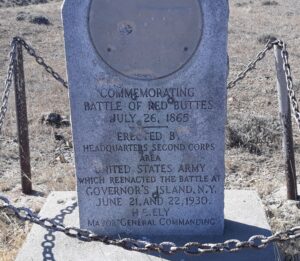
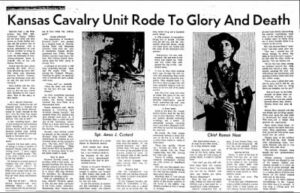 22 men with the wagons were killed, including Custard. Only three men escaped and reached safety at Platte Bridge Station. That was a horrific day, and in the end, 29 US soldiers and at least eight Native American warriors were killed in the Battles of Platte Bridge and Red Buttes. “Custard’s Last Stand” would later spur “Custer’s Last Stand” as the soldiers went after the Indians who had been the cause of so much bloodshed.
22 men with the wagons were killed, including Custard. Only three men escaped and reached safety at Platte Bridge Station. That was a horrific day, and in the end, 29 US soldiers and at least eight Native American warriors were killed in the Battles of Platte Bridge and Red Buttes. “Custard’s Last Stand” would later spur “Custer’s Last Stand” as the soldiers went after the Indians who had been the cause of so much bloodshed.
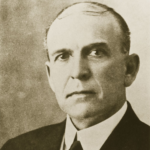 Douglas Arnold Preston was destined for great things in the state of Wyoming. Born on December 19, 1858, to Finney D Preston and Phoebe Mundy. He was admitted to the Illinois bar in 1878 and practiced law in Illinois courts until 1887. Then he decided to relocate to Cheyenne, Wyoming Territory. During his life in Wyoming, Preston was not only an attorney, but also a politician. He served as the 6th Attorney General of Wyoming from 1911 to 1919, as a member of the Democratic Party. He also served as a member of the Wyoming House of Representatives from 1903 to 1905, and as a member of the Wyoming Senate in 1929 until his death.
Douglas Arnold Preston was destined for great things in the state of Wyoming. Born on December 19, 1858, to Finney D Preston and Phoebe Mundy. He was admitted to the Illinois bar in 1878 and practiced law in Illinois courts until 1887. Then he decided to relocate to Cheyenne, Wyoming Territory. During his life in Wyoming, Preston was not only an attorney, but also a politician. He served as the 6th Attorney General of Wyoming from 1911 to 1919, as a member of the Democratic Party. He also served as a member of the Wyoming House of Representatives from 1903 to 1905, and as a member of the Wyoming Senate in 1929 until his death.
When Preston moved to Wyoming in 1887, he established a law office in Rawlins in partnership with John R Dixon. Apparently, Rawlins wasn’t his cup of tea, so the following year, he moved to Lander, where he continued his legal practice. In 1895, he again relocated, settling in Rock Springs, which became his long-term residence and base for his legal and political career.
While Preston’s political career was extensive, probably one of the oddest parts of his legal career was the fact that he was once retained as a defense attorney for the infamous Butch Cassidy. Cassidy and his cohort, Al Hainer, had been arrested on April 11, 1892, a seven-man posse led by Uinta County Sheriff John Ward and Deputy Sheriff Bob Calverly, and charged in Fremont County with grand larceny “involving the theft of a horse valued at forty dollars from the Grey Bull Cattle Company on or about October 1, 1891.” District Court Judge Jesse Knight set bond at $400 each and both men were released pending trial. The trial was delayed for more than a year, due mostly to problems encountered in locating one prosecution witness and several defense witnesses. During that time, Cassidy retained Douglas A Preston of Lander as his attorney. Preston was assisted by C F Rathbone.
Preston and Cassidy had crossed paths and become friends so retaining him made sense. Unsubstantiated 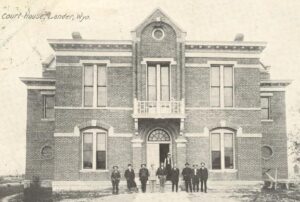 rumor has it that Cassidy and Preston met when Cassidy saved Preston from a beating in a saloon in Rock Springs. However, that rumor has been disputed, and since Cassidy was an outlaw, it seems odd that he would play the hero in that one situation. Nevertheless, the two men were friends, and Preston did defend Cassidy.
rumor has it that Cassidy and Preston met when Cassidy saved Preston from a beating in a saloon in Rock Springs. However, that rumor has been disputed, and since Cassidy was an outlaw, it seems odd that he would play the hero in that one situation. Nevertheless, the two men were friends, and Preston did defend Cassidy.
The trial finally began in Lander on June 20, 1893, with Judge Knight presiding. The trial was short and the defense simple. Cassidy and Hainer did not deny being in possession of the horses but maintained they had bought them from a man named Billy Nutcher in good faith, unaware they were stolen. Conveniently, though he had been subpoenaed to testify, Nutcher did not appear at the trial. Nor did two men Cassidy claimed had witnessed the transaction. In the end, the jury deliberated only a few hours before finding both men not guilty. The reality was that there was just not enough evidence.
As the trial progressed and a “not guilty” verdict appeared likely, rancher Otto Franc filed charges against Cassidy and Haines in the theft of different horses in August of 1891, valued at $50. Both were re-arrested and were once again freed on bond. The trial on the new charge opened on June 30, 1894. While Cassidy was found guilty, Hainer was once again acquitted. On July 10, Judge Knight sentenced Cassidy to two years at hard labor in the Wyoming State Penitentiary in Laramie. That pretty much ended the relationship with Preston and Cassidy, and Preston went on to focus on his political career.
Preston served as the prosecuting attorney for Richland County, Illinois from 1880 to 1894. By 1889, and now in Wyoming since 1887, Preston was selected as one of the Democratic delegates to the Wyoming Constitutional Convention. Their task was to draft the state’s constitution for submission to the US government 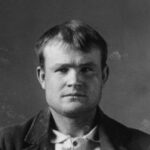 for statehood. From 1903 to 1905, Preston served in the Wyoming House of Representatives. Governor Joseph M Carey appointed him as Attorney General of Wyoming in 1911, and he was reappointed by Governor John B Kendrick in 1915.
for statehood. From 1903 to 1905, Preston served in the Wyoming House of Representatives. Governor Joseph M Carey appointed him as Attorney General of Wyoming in 1911, and he was reappointed by Governor John B Kendrick in 1915.
Preston was elected to the Wyoming Senate in 1928, but on October 8, 1929, he was involved in a car crash that left him with four broken ribs and a severe skull fracture. Unable to recover from his injuries, Preston died on October 21, 1929, in a hospital in Rock Springs, Wyoming. He was 70 years old. In the 1930 Wyoming state elections, his widow, Anna Preston, was nominated as the Democratic candidate for Wyoming Superintendent of Public Instruction.
 Beating the computer…sound impossible. Well for most of us, it probably is. Garry Kasparov would be the exception to that statement. Still, it was not a common event…even for Kasparov. On February 10, 1996, at the Pennsylvania Convention Center in Philadelphia, Kasparov was beaten by a computer called Deep Blue in the first game of a six-game match, marking the first time a computer had ever beat a human in a formal chess game. Prior to that time, most likely no one had programmed a computer to really play chess. So, it was experimental. Since that time, computers have improved significantly, and today they can easily surpass scores of 3500, while the current all-time human record is 2882. Not being a chess player, I can’t exactly say that that I know about the scoring system.
Beating the computer…sound impossible. Well for most of us, it probably is. Garry Kasparov would be the exception to that statement. Still, it was not a common event…even for Kasparov. On February 10, 1996, at the Pennsylvania Convention Center in Philadelphia, Kasparov was beaten by a computer called Deep Blue in the first game of a six-game match, marking the first time a computer had ever beat a human in a formal chess game. Prior to that time, most likely no one had programmed a computer to really play chess. So, it was experimental. Since that time, computers have improved significantly, and today they can easily surpass scores of 3500, while the current all-time human record is 2882. Not being a chess player, I can’t exactly say that that I know about the scoring system.
Being beaten at chess was not something Kasparov took kindly to. After all, he was a world class player. Nobody was supposed to beat him, much less a machine. He could hardly stand it. It became an obsession. He was determined to beat the computer. Then, on February 17th…the final day of the tournament, Kasparov actually beat Deep Blue. It was the final game of a six-game match, and IBM’s chess-playing computer finally lost. Kasparov won the match, 4-2. While he had his victory, the sweetness of it was short lived, because the  following year, in a widely publicized rematch, Deep Blue once again went on to defeat Kasparov.
following year, in a widely publicized rematch, Deep Blue once again went on to defeat Kasparov.
Kasparov was born April 13, 1963, in the Russian republic of Azerbaijan. In 1985, at 22, Kasparov became the youngest world champion in history when he defeated Anatoly Karpov. The computer, Deep Blue can also be traced back to 1985, when Feng Hsiung Hsu, a Carnegie Mellon University doctoral student, began developing a chess-playing computer called “ChipTest,” which later became known as “Deep Thought,” after a machine in the science-fiction novel The Hitchhiker’s Guide to the Galaxy by Douglas Adams. IBM saw value in Hsu and his collaborators, Murray Campbell, and Thomas Anantharaman, and later hired them, to continue to work on the chess-playing computer. Deep Thought evolved, but in 1989, Gary Kasparov easily trounced it when they met for a 2-game match. Not giving up, the IBM team continued to refine their supercomputer. In 1993, it was renamed “Deep Blue,” a combination of Deep Thought and Big Blue, which was IBM’s nickname.
“Deep Blue” was capable of evaluating 100 million different chess positions per second. Nevertheless, the IBM team wasn’t sure how the computer would perform in competition and Kasparov was favored to win. How odd is  it that a man was favored to win over a computer. Still, it was so. In a frustrating turn of events, Kasparov lost the first game to “Deep Blue.” Not to be outdone, he came back and won the second game. The third and fourth games ended in a draw, and Kasparov won the fifth game. On February 17, the human chess master triumphed over Deep Blue in the sixth game and took the match, with a final score of 4-2. Of course, computers have evolved over the years, and these days it is believed that no human cam beat the computer. I guess time will tell if that is the case. As for Kasparov, well, he retained his world chess champion title until 2000. In March 2005, he announced his retirement from professional chess.
it that a man was favored to win over a computer. Still, it was so. In a frustrating turn of events, Kasparov lost the first game to “Deep Blue.” Not to be outdone, he came back and won the second game. The third and fourth games ended in a draw, and Kasparov won the fifth game. On February 17, the human chess master triumphed over Deep Blue in the sixth game and took the match, with a final score of 4-2. Of course, computers have evolved over the years, and these days it is believed that no human cam beat the computer. I guess time will tell if that is the case. As for Kasparov, well, he retained his world chess champion title until 2000. In March 2005, he announced his retirement from professional chess.
 Potatoes weren’t very popular in France at first. This changed when Antoine-Augustin Parmentier took matters into his own hands to promote the potato as a food source for humans in France. He’d surround his potato patch with guards during the day, to suggest valuable goods were growing there, and then remove the guards at night so people would come and steal the potatoes. You might ask why he would do such a thing. Well, during the Seven Years War, when Parmentier was a prisoner of war, he was given potatoes and discovered their nutritional value. Before Parmentier’s efforts, the French thought that potatoes were poisonous and disgusting. Parmentier’s potato patch was a plot of land near Neuilly, west of Paris. There he grew potatoes to promote their consumption. Parmentier’s efforts were successful in making potatoes a staple of the French diet.
Potatoes weren’t very popular in France at first. This changed when Antoine-Augustin Parmentier took matters into his own hands to promote the potato as a food source for humans in France. He’d surround his potato patch with guards during the day, to suggest valuable goods were growing there, and then remove the guards at night so people would come and steal the potatoes. You might ask why he would do such a thing. Well, during the Seven Years War, when Parmentier was a prisoner of war, he was given potatoes and discovered their nutritional value. Before Parmentier’s efforts, the French thought that potatoes were poisonous and disgusting. Parmentier’s potato patch was a plot of land near Neuilly, west of Paris. There he grew potatoes to promote their consumption. Parmentier’s efforts were successful in making potatoes a staple of the French diet.
While trying to promote potatoes, Parmentier did crazy things, like holding dinners where he served potato dishes. I can only imagine how hard it was to get people to try  his dishes. He also gave bouquets of potato flowers to the king and queen…seriously!! I wonder how the king and queen reacted to that!! Parmentier also surrounded his potato patch with armed guards during the day, and instructed them to let thieves steal the potatoes at night. That way, the people thought the potatoes were some kind of exotic good of great value. He also published a Treatise on the Culture and Use of the Potato, Sweet Potato, and Jerusalem Artichoke in 1789. This man was totally dedicated to the potato.
his dishes. He also gave bouquets of potato flowers to the king and queen…seriously!! I wonder how the king and queen reacted to that!! Parmentier also surrounded his potato patch with armed guards during the day, and instructed them to let thieves steal the potatoes at night. That way, the people thought the potatoes were some kind of exotic good of great value. He also published a Treatise on the Culture and Use of the Potato, Sweet Potato, and Jerusalem Artichoke in 1789. This man was totally dedicated to the potato.
Born on August 12, 1737, Parmentier was a French pharmacist and agronomist, who was best remembered as a vocal promoter of the potato as a food source for humans in France and throughout Europe, but his many other contributions  to nutrition and health included establishing the first mandatory smallpox vaccination campaign in France (under Napoleon beginning in 1805, when he was Inspector-General of the Health Service) and pioneering the extraction of sugar from sugar beets. Parmentier also founded a school of breadmaking and studied methods of conserving food, including refrigeration.
to nutrition and health included establishing the first mandatory smallpox vaccination campaign in France (under Napoleon beginning in 1805, when he was Inspector-General of the Health Service) and pioneering the extraction of sugar from sugar beets. Parmentier also founded a school of breadmaking and studied methods of conserving food, including refrigeration.
Parmentier died on December 13, 1813. He was 76. He is buried in Père Lachaise Cemetery in Paris. His grave is ringed by potato plants. He was also honored with his name given to a long avenue in the 10th and 11th arrondissements (and a station on line 3 of the Paris Métro). His bronze statue was placed at Montdidier and surveys Place Parmentier from its high socle, while below, in full marble relief, seed potatoes are distributed and another monumental statue of Parmentier, by French sculptor Adrien Étienne Gaudez, in the square of the town hall of Neuilly-sur-Seine.
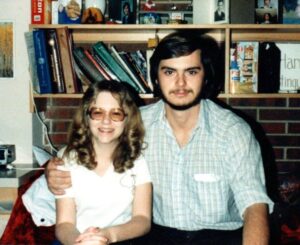
 While I didn’t see her in person very often, my cousin Liz Byer was a bright light shining from Facebook into the lives of those privileged enough to call her friend. She loved flowers, making Spring and Summer her seasons of choice, but she actually received a gift from Jesus on December 27th, when some of her outdoor flowers decided to be “blooming idiots” by blooming in the Winter. Leave it to Liz to come up with that. The reality is that she often came up with funny things. That was a big part of her charm. She would post things like “All of my flabbers are gasted” or show a picture of the birds at her “cat food bistro.” You really had no choice but to laugh at the stuff she found to brighten the day of anyone who followed her page. I would often go look at her page just to start my day with a smile. Oh…how I will miss those silly little posts.
While I didn’t see her in person very often, my cousin Liz Byer was a bright light shining from Facebook into the lives of those privileged enough to call her friend. She loved flowers, making Spring and Summer her seasons of choice, but she actually received a gift from Jesus on December 27th, when some of her outdoor flowers decided to be “blooming idiots” by blooming in the Winter. Leave it to Liz to come up with that. The reality is that she often came up with funny things. That was a big part of her charm. She would post things like “All of my flabbers are gasted” or show a picture of the birds at her “cat food bistro.” You really had no choice but to laugh at the stuff she found to brighten the day of anyone who followed her page. I would often go look at her page just to start my day with a smile. Oh…how I will miss those silly little posts. 
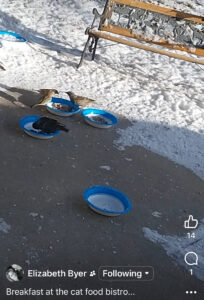
Liz was born with Brittle Bone Disease, but she never let that get her down. She always wore a smile and always had a kind word or a funny quip to lift the spirits of those around her. You may not have even been feeling down, but after you talked to Liz or read her posts, you knew that your day got just a little bit brighter. She had a way of making your day better, even when you didn’t know you needed that. That is a person who is a bright light. That was Liz.
Liz’s top priority, after the Lord, was her family. She was married to my cousin Tim Byer on July 12, 1986. I’m sure that one of the things Tim noticed first about Liz, was her winning smile. You could just see the joy in her heart through her smile. Their marriage brought them two sweet daughters, Danielle Elizabeth and Nickole Marie, and when the girls married, they added James Forseen and Caleb Holscher. Liz and Tim now have six beautiful grandchildren, Natasha Elizabeth, Eleanor Mercedes, Joanna Carlyne, and Henry Axel Forseen; and James Timothy and Judah Everett 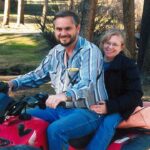
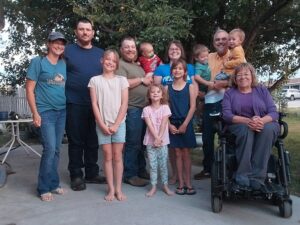 Holscher. They are her pride and joy. Together, Liz and Tim started a beautiful family, and their family will continue on long into the future. While her home going will bring sadness to the family, they know that because she had accepted Jesus as her Lord and Savior, she is not in their past now, but rather in their future. They will see her again when they all join her in Heaven with the Lord. We will all miss Liz very much. Liz, we love you and look forward to seeing you again when we go to Heaven too.
Holscher. They are her pride and joy. Together, Liz and Tim started a beautiful family, and their family will continue on long into the future. While her home going will bring sadness to the family, they know that because she had accepted Jesus as her Lord and Savior, she is not in their past now, but rather in their future. They will see her again when they all join her in Heaven with the Lord. We will all miss Liz very much. Liz, we love you and look forward to seeing you again when we go to Heaven too.

